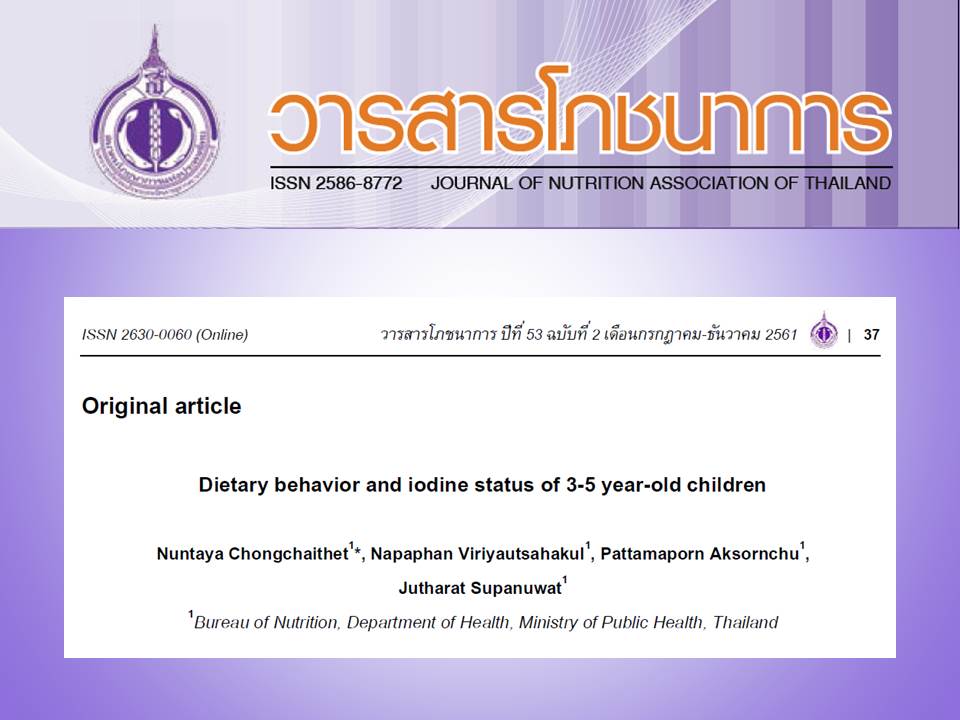Dietary Behavior and Iodine Status of 3-5 Year-old Children
Keywords:
Iodine status, Dietary behavior, 3-5 year-old childrenAbstract
According to the survey of iodine deficiency among 3-5 year-old Thai children during 2011-2013 by the Department of Health, the median urinary iodine concentration showed adequate iodine intake and tend to above requirement which can lead to hyperthyroidism and autoimmune thyroid diseases. This study aimed to investigate dietary behavior, iodine contents in foods, iodine status and the association between iodine intake and urinary iodine concentration among 3-5 year-old children. This study was investigated in 3-5 year old children at child development centers from 11 provinces representative for 4 regions of Thailand. Food intakes were assessed using interviewing and food frequency questionnaire. The 2209 parents (female=1,882 and male=327) were interviewed about food consumption of their children. Iodine contents were determined in both food and urine. The results showed that the top ten favorite foods were milk, egg, snacks, beverage, sausages, drinking yogurt, instant noodle, seaweed, cocoa and meat ball. Proportions of the food consumption were 98.1, 91.3, 81.1, 66.5, 58.4, 56.1, 48.5, 40.8, 38.6 and 37.9%, respectively. Iodine contents in top ten favorite foods were 30.0, 91.2, 20.6, 0, 735.9, 10.7, 170.8, 1311.2, 0 and 13.3 mg/100g, respectively. Median urinary iodine concentration of 3-5 year-old children (n=2622) was 241.6 µg/l and median urinary iodine concentrations were 273.4, 242.7, 242.7, and 221.8 mg/l in children from southern, central, northern and north-eastern regions, respectively. This study indicated that Iodine status in 3-5 year-old children is adequate and food sources of iodine were milk, egg, instant noodle and seaweeds. However, these foods did not show any association with urine iodine concentration.
References
Zimmermann MB. Iodine deficiency. Endocrine Reviews. 2009;30:376-408.
World Health Organization, International Council for the Control of the Iodine Deficiency Disorders, United Nations Children Fund. Assessment of the iodine deficiency disorders and monitoring their elimination. 3rd ed. Geneva: WHO; 2007.
Zimmermann MB. Iodine requirements and the risks and benefits of correcting iodine deficiency in populations. J Trace Elem Med Biol. 2008;22:81-92.
นภาพรรณ วิริยะอุตสาหกุล. การควบคุมป้องกันโรคขาดสารไอโอดีน: เส้นทางสู่ความยั่งยืน.กรุงเทพมหานคร: สามเจริญพาณิชย์ (กรุงเทพ); 2559.
Pennington JA. Iodine toxicity. Springfield, VA: National Technical Information Service, US department of commerce; 1989.
Institute of Medicine, Food and Nutrition Board. Dietary reference intakes for vitamin A, vitamin K, arsenic, boron, chromium, copper, iodine, iron, manganese, molybdenum, nickel, silicon, vanadium, and zinc. Washington: National Academy Press; 2001.
Pennington JA. A review of iodine toxicity reports. J Am Diet Assoc. 1990;90:1571-81.
สำนักมาตรฐานสินค้าและระบบคุณภาพ สำนักงานมาตรฐานสินค้าเกษตรและอาหารแห่งชาติ. ข้อมูลการบริโภคอาหารของประเทศไทย. กรุงเทพมหานคร: สำนักมาตรฐานสินค้าและระบบคุณภาพ สำนักงานมาตรฐานสินค้าเกษตรและอาหารแห่งชาติ; 2549.
Moxon RE, Dixon EJ. Semi-automatic method for the determination of total Iodine in food. Analyst. 1980;105:344-52.
Ohashi T, Yamaki M, Pandav CS, Karmarkar MG, Irie M. Simple microplate method for determination urinary iodine. Clinical Chemistry. 2000;46:529-36.
มันทนา ประทีปะเสน, เรวดี จงสุวัฒน์, สุจิตต์ สาลีพันธ์, พูนศรี เลิศลักขณวงศ์. รายงานการสำรวจภาวะอาหารและโภชนาการของประเทศไทย ครั้งที่ 5 พ.ศ.2546. กรุงเทพมหานคร: โรงพิมพ์องค์การรับส่งสินค้าและพัสดุภัณฑ์; 2546.
Klunklin S, Channoonmuang K. Snack consumption in normal and undernourished preschool children in Northeastern Thailand. J Med Assoc Thai. 2006;89:706-13.
Wikipedia. Erythrosine [Internet]. 2012 [updated 2017 Oct 20; cited 2017 Dec 10]. Available from: https://en.wikipedia.org/wiki/Erythrosine
EFSA Panel on Food Additives and Nutrient Sources added to Food (ANS). Scientific opinion on the re-evaluation of Erythrosine (E 127) as a food additive. EFSA Journal. 2011;9(1):1854.
Rasmussen LB, Ovesen L, Bülow I, Jørgensen T, Knudsen N, Laurberg P, et al. Dietary iodine intake and urinary iodine excretion in a Danish population: effect of geography, supplements and food choice. Br J Nutr. 2002;87:61-9.
Vanderpump MP, Lazarus JH, Smyth PP, Laurberg P, Holder RL, Boelaert K, et.al. Iodine status of UK schoolgirls: a cross-sectional survey. Lancet. 2011;377:2007-12.
Iodine Global network. Global scorecard of Iodine Nutrition in 2017 in the general population and in pregnant women (PW) [Internet]. 2017 [updated 2017 May 30; cited 2018 May 25]. Available from: http://www.ign.org/scorecard.htm
วิชัย เอกพลากร. รายงานการสำรวจสุขภาพประชาชนไทยโดยการตรวจร่างกาย ครั้งที่ 4 พ.ศ.2551-2552. กรุงเทพมหานคร: เดอะกราฟิโก ซิสเต็มส์; 2552.

Downloads
Published
How to Cite
Issue
Section
License
Upon acceptance of an article, copyright is belonging to the Nutrition Association of Thailand.


